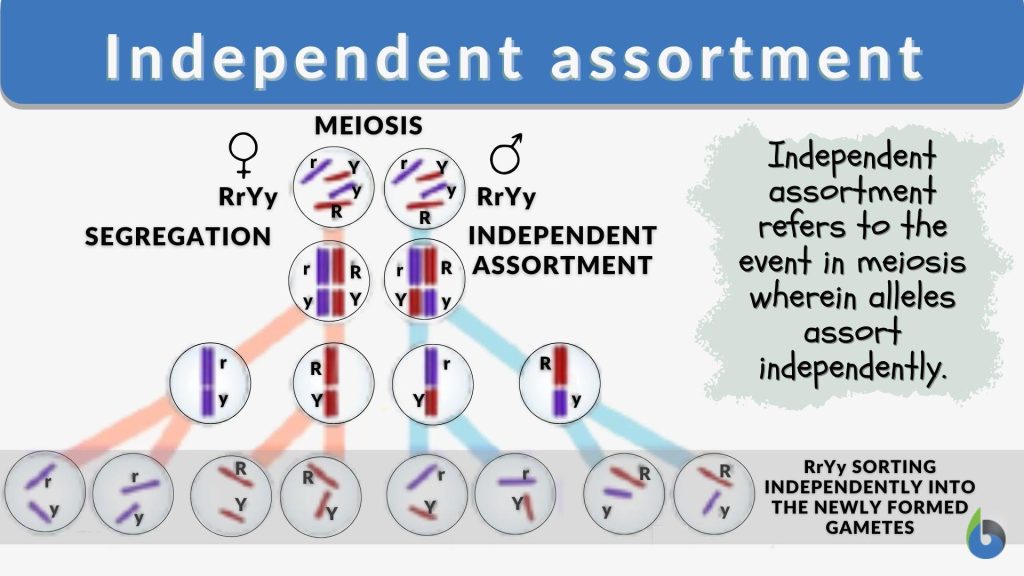
What is the Law of Independent Assortment?
The Law of Independent Assortment, discovered by Gregor Mendel in 1865, states the alleles of unrelated genes segregate independently during the formation of gametes. This theory revolutionized the field of genetics and has been an essential part of creating an understanding of how traits are inherited and passed on from one generation to another.
Understand the Law of Independent Assortment.
The law of independent assortment explains how different genes for different traits can be randomly combined during the formation of gametes. This means that there is no specific pattern or order in which genes are inherited. Each gene has an equal chance of being passed on to an offspring, unrelated to any other gene present in the same organism’s genome.
Explore the Historical Context of Mendel’s Laws of Inheritance. law of independent assortment
Gregor Mendel is credited with introducing the concept of ‘inheritance of traits’ in his famous studies on Pisum sativum (common pea). His research was based on the laws of segregation and independent assortment, which he formally presented in 1865. In his experiments, Mendel crossbred true-breeding lines of the pea plants and concluded that the traits for each characteristic were passed down independently to their offspring.
Examine Chromosomal Segregation and Genetic Recombination.
According to the law of independent assortment, during meiosis (the process of cell division that forms eggs and sperm cells) chromosomes segregate independently of other chromosomes. This means that the inheritance of one trait does not affect or influence the inheritance for another trait. As a result, these traits recombine in each generation and can produce an infinite number of combinations in any particular offspring.
Grasp How Genes are Inherited from One Generation to the Next.
Gregor Mendel’s discovery of the law of independent assortment gave scientists the ability to understand how genes are inherited from one generation to the next. As we now understand it, this law can help us predict the likelihood of particular traits being inherited in any given offspring. By understanding how combinations of alleles (variations of gene) can be a predictor for certain traits, we can grasp how genetics influences heredity and ultimately how those traits may vary from one individual to the next.
Consider Modern Applications in Genetics and Science Today.
Now, the law of independent assortment is applied every day in modern genetics and science. It enables researchers to predict how likely a child will be to inherit certain genetic traits from their parents or grandparents by considering the combinations of alleles that can determine these traits. It is also used to understand the patterns of gene expression and the law has become a fundamental component of breeding practices, specifically in crop production. By understanding this law, we can make more accurate predictions on heredity and, ultimately, on a species’ potential evolution.
Independent Assortment Definition
The law of independent assortment, proposed by Gregor Mendel, states that genetic traits from different chromosomes will be randomly segregated into gametes independently of one another. This is due to the independent division of homologous chromosomes during meiosis. Some combinations may be unlikely, but all possible combinations are equally likely given sufficient trials. This law is just one of the laws of inheritance that Mendel proposed, and it remains a fundamental concept in the study of genetics today.
What is the Law of Independent Assortment?
Welcome to the fascinating world of genetics, where the Law of Independent Assortment reigns supreme!
Picture this: a symphony of genes, swirling and mingling, each one carrying the blueprint of life as we know it. Within this intricate dance lies an essential principle, the Law of Independent Assortment, which governs how genetic traits are passed from one generation to the next.
At its core, the Law of Independent Assortment states that the inheritance of one gene does not affect the inheritance of another gene. In simpler terms, it means that the assortment of genes in offspring is random and entirely independent of one another.
Key Features:
- The Law of Independent Assortment is one of the fundamental principles of genetics.
- It was first introduced through the observations and experiments conducted by the brilliant Gregor Mendel, the father of modern genetics.
- This law applies to genes located on different chromosomes, ensuring the diversity and variation in genetic combinations.
- Through the mechanism of crossing over during meiosis, genetic recombination occurs, further enhancing the potential for unique genetic outcomes.
- The Law of Independent Assortment is a cornerstone for understanding inheritance patterns and predicting the likelihood of specific traits appearing in future generations.
Benefits and Value:
Understanding the Law of Independent Assortment opens up a world of possibilities in genetics. It empowers scientists and geneticists to decipher the intricate code of heredity, unraveling the mysteries encoded within our DNA. By comprehending this law, researchers can:
- Develop more accurate predictions regarding the inheritance of genetic diseases and disorders, leading to earlier diagnoses and improved treatments.
- Unlock the potential for selective breeding, allowing farmers to cultivate crops with desired traits, or breeders to choose specific characteristics in animals.
- Expand our knowledge of evolutionary processes, as the independent assortment of genes contributes to the diversity and adaptation seen in living organisms.
- Enhance genetic counseling services, aiding individuals in understanding their likelihood of passing on specific traits to their offspring.
So, dear reader, venture forth into the realm of the Law of Independent Assortment, where genes dance independently and create a symphony of life. Unravel its mysteries, grasp its significance, and be captivated by the potential it holds in shaping the world as we know it!
Disclaimer: No genes were harmed in the making of this captivating description.


